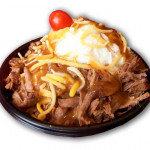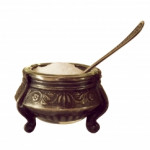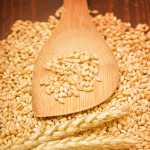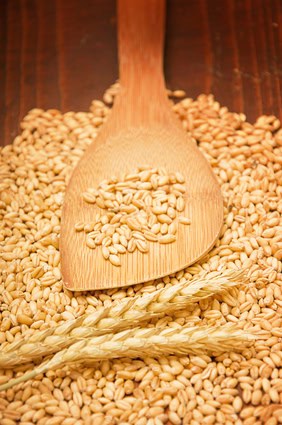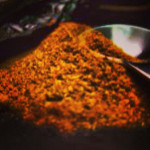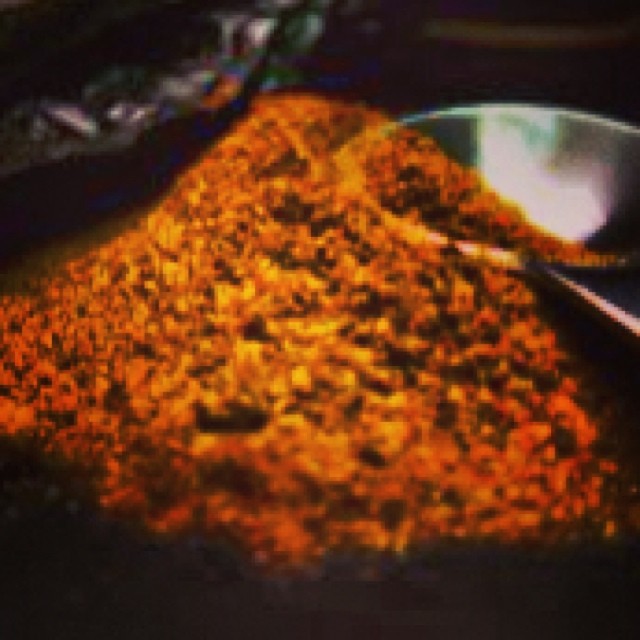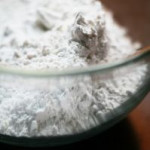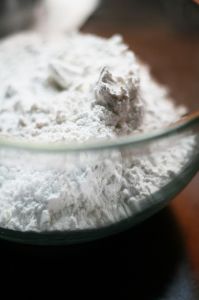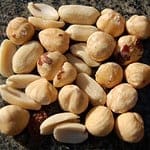A hastily gulped cupful each morning does not give coffee its due. How much more satisfying to make it an afternoon ritual, replete with sweet and savory snacks. A turn-of-the-century wedding gift might have been a cut crystal coffee pot. Today, a large silver urn means that guests can fill, and refill, their cups at their leisure.
© Victoria Hart Glavin
I find these heavy duty clips at the hardware store and use them to clip shut bags and various things that need a strong clip. Price is 37 cents each.
Hot Beef Sundae
At the New York and Indiana State Fair in August the Hot Beef Sundae will be served. Just what is a Hot Beef Sundae you ask? Touted as the ultimate comfort food, the Hot Beef Sundae is a generous helping of buttery mashed potatoes surrounded by slow-roasted roast beef and gravy, sprinkled with cheddar cheese, and garnished with a cherry tomato. It may look like a sundae, but this puppy is all Sunday dinner!
© Victoria Hart Glavin
Biodynamic Agriculture
Caring for the living land is what it’s all about. Biodynamic and organic farming have a lot in common. Both produce high-quality food without the use of pesticides, chemical fertilizers or GMOs. But biodynamic farmers act on an even broader vision of land stewardship. They view their land as a living organism, and they care for its well being by balancing the demands of growing food with practices aimed at continuously renewing the farm’s natural resources.
On a biodynamic farm, the inputs (such as fertilizer) that go into raising food are produced and recycled on the farm. Crops are nourished by fermented manure, minerals and herbs generated on the farm. Water is refreshed and reused on the farm. Riparian zones, wetlands, grasslands, and forests are treated as an integral part of the farm’s ecosystem. Biodynamic farmers set aside at least 10% of their total land for biodiversity. And they also consider the climate, wildlife and they cycles of the sun and moon all part of the farm’s living relationship with nature.
You will see product labeled as “biodynamic” in health food markets. To carry the biodynamic label, the products must be certified by Demeter USA, a nonprofit that is part of the world’s oldest agriculture certification body (Demeter International). The USDA’s Organic Standards are a base level that every certified biodynamic farm must meet. Biodynamic certification also requires a careful examination and eventual elimination of imported materials to farm.
“What kills bugs kills people.” – Clifford G. Shane Former Director, Region VII, U. S. Food and Drug Administration (My Great Uncle)
© Victoria Hart Glavin
 Lots of New Yorkers don't cook and some use their ovens as a file cabinet. When I first moved to NYC I sublet an UWS apt from a mean and nasty woman who was a producer at CBS. Wherever I'm living, no matter how tiny, I cook. This woman assured me that not once in the 35 years that she had lived in the apt had she turned on the oven. It was a good thing that I opened the oven BEFORE turning it on because there in the oven were tons of filled file folders with bills and receipts from many many years. I had to bake the cookies that I just prepared so I thought for two seconds about what to do and pulled the files all out, opened up the trash bin and threw them all out. Seriously, who keeps 20 year old files in the oven?
Lots of New Yorkers don't cook and some use their ovens as a file cabinet. When I first moved to NYC I sublet an UWS apt from a mean and nasty woman who was a producer at CBS. Wherever I'm living, no matter how tiny, I cook. This woman assured me that not once in the 35 years that she had lived in the apt had she turned on the oven. It was a good thing that I opened the oven BEFORE turning it on because there in the oven were tons of filled file folders with bills and receipts from many many years. I had to bake the cookies that I just prepared so I thought for two seconds about what to do and pulled the files all out, opened up the trash bin and threw them all out. Seriously, who keeps 20 year old files in the oven?
© Victoria Hart Glavin
A Few Words About Grains
Grains have become popular lately not only because they are nutritious, but because they are delicious, too. They are not difficult to cook. If you can cook rice, you can cook grains, however, they can be unpredictable, with cooking times that can vary widely.
Ways To Use Grains
Pilaf tossed with sautéed vegetables and fresh herbs
In place of rice or noodles in soup
Cooked with dried fruit and topped with milk or yogurt for breakfast
Tossed with chopped vegetables and a vibrant vinaigrette for a salad
Base for curries and stir-fries
Hearty stuffing for vegetables and roasts
Basic Grain Instructions
Storing: Grains stored in airtight containers away from light, heat and moisture should keep a few months. The oils in some whole grains may turn rancid over time, so be sure to smell before using. If they smell musty or off, they may be past their prime.
Rinsing and Soaking: Rinse grains thoroughly under cold running water until the water runs clear. Soaking is optional, but it is recommended for hard grains like kamut, spelt, and wheat berries. They will cook up quicker and maintain their integrity.
Boil/Simmer: Bring water (as salt, if using) to a boil, add grains and return to a boil. Stir, reduce heat so the water just simmers, cover the pot tightly, and simmer. Resist the urge to lift the cover. Releasing steam will slow the cooking process.
Test: Check grains for doneness by biting into it. Most whole grains are slightly chewy when cooked.
Fluff: When grains are done cooking, remove from the heat and fluff them with a fork or chopstick. Cover again and allow to sit for 5 to 10 minutes before serving.
Grain Varieties
Amaranth: Becomes sticky when cooked. Mix with corn, scallions and cooked pinto beans for a South-of-the Border side dish. Grain to liquid is 1 cup to 3 cups. Simmer 25 to 30 minutes. Do not salt until thoroughly cooked.
Barley (Brown): Lightly milled to retain all of the germ and at least 2/3 of the bran for a tender, slightly chewy texture and a mild flavor. Use in grain salads, soups, stews, and chilis. Try barley as a stuffing for peppers, tomatoes or poultry. Grain to liquid is 1 cup to 3 1/2 cups. Simmer 60 minutes.
Bulgur: Bulgur is cracked wheat that has been partially cooked. Most often used to make tabbouleh, a Middle Easter salad featuring parsley, mint, garlic, and lemon. Grain to liquid is 1 cup to 2 1/2 cups. Simmer 20 minutes, fluff, let sit covered for 10 minutes. Or pour boiling water over bulgur, cover and let sit for 1 hour.
Couscous: Made from coarsely ground, precooked semolina, couscous is technically a pasta, but is typically used like a grain. It cooks up in minutes, making it a lifesaver for weeknight cooking. Delicious tossed with fresh herbs, lemon, and toasted pine nuts. Grain to liquid is 1 cup to 1 1/2 cups. Place couscous in a bowl. Pour in lightly salted boiling water, cover and let sit until water is absorbed and couscous is tender, 5 to 10 minutes. Fluff.
Couscous (Whole Wheat): Whole wheat couscous retains the chewy bran layer of the semolina, which adds a nutty flavor and makes it slightly more nutritious. Delicious tossed with basil, garlic, and Parmesan. Grain to liquid is 1 cup to 1 1/2 cups. Place couscous in a bowl. Pour in lightly salted boiling water, cover and let sit until water is absorbed and couscous is tender, 5 to 10 minutes. Fluff.
Cracked Wheat: Wheat berries cracked into small pieces. Use in casseroles, salads or as a stuffing. Grain to liquid is 1 cup to 2 cups. Simmer 30 minutes, let stand covered 5 minutes.
Grits: Ground yellow corn that cooks to a puddinglike consistency similar to polenta. The coarser the grind, the longer the cooking time. Grain to liquid is 1 cup to 4 cups. Bring water to a boil (salt optional). Reduce heat slightly and slowly. Whisk in grits. Cook covered 15 to 20 minutes. Remove from heat and let stand 5 minutes.
Kamut: An ancient Egyptian wheat cultivated since 4000 BC, kamut has a rich, buttery flavor and a chewy texture. Grain to liquid is 1 cup to 3 cups. Soak overnight in cold water. Drain. Simmer 45 to 60 minutes.
Kasha: Kasha is whole-roasted buckwheat groats. Because buckwheat is not part of the wheat family, it can be eaten by many on a wheat-free diet. Cook with noodles, use as a stuffing for cabbage, or use in casseroles. Grain to liquid is 1 cup to 2 cups. Simmer 20 minutes.
Millet: A mild, very digestible grain, often used by people on wheat-free diets. Use interchangeably with quinoa or rice. Grain to liquid is 1 cup to 2 1/2 cups. Simmer 25 to 35 minutes, remove from heat, fluff and let sit uncovered for 20 minutes.
Oat Groats: Rich and hearty, a great alternative to oatmeal. Also used in savory dishes like pilaf or stuffing. Grain to liquid is 1 cup to 3 cups. Start in cold water and then simmer for 1 to 1 1/2 hours.
Oats (Steel-Cut): Chewier than rolled oats, steel-cut oats are groats cut into smaller pieces. A perfect hot cereal for cool-weather breakfast. Grain to liquid is 1 cup to 4 cups. Start in cold water and then simmer for 30 minutes.
Oats (Rolled): Often called old-fashioned oats, rolled oats are groats that have been steamed, rolled and cut into flakes. Great as cereal or added raw to cookies, muffins, pancakes, and granola. Grain to liquid is 1 cup to 2 cups. Start in cold water and then simmer for 10 to 15 minutes.
Quinoa: Pronounced (KEEN-wah), this ancient grain is packed with nutrition and has a light, nutty flavor that works well in soups, salads and pilafs. Grain to liquid is 1 cup to 2 cups. Rinse well before cooking. Simmer 15 to 20 minutes.
Rye Berries: Nutty rye berries have a terrific chewy texture that works well in a pilaf with brown rice, onion, parsley ad caraway seeds, or add cooked berries to baked goods for heartiness. Grain to liquid is 1 cup to 4 cups. Soak overnight. Simmer 1 hour.
Rye Flakes: Rye berries that are steamed and rolled. Great mixed with rolled oats for a warming winter cereal. A hearty addition to breads and muffins. Grain to liquid is 1 cup to 3 cups. Simmer for 25 to 30 minutes. Bring water to a boil, add salt (optional), slowly add cereal, stirring constantly. Simmer 15 minutes, stirring occasionally.
Seven Grain Cereal: Includes organic wheat, oats, barley, soybeans, buckwheat, wheat bran, corn and millet. Grain to liquid is 1 cup to 2 1/2 cups. Bring water to boil, add salt (optional), slowly add cereal, stirring constantly. Simmer 15 minutes, stirring occasionally.
Spelt Berries: A mild, very digestible grain, often used by people on wheat-free diets. Use interchangeably with quinoa or rice. Grain to liquid is 1 cup to 4 cups. Soak 8 hours or overnight. Drain. Add water, bring to a boil and simmer 50 to 60 minutes.
Teff: A rich source of calcium and iron, and it’s gluten-free. Makes a great morning cereal with a creamy-crunchy texture and a light molasses flavor. Grain to liquid is 1 cup to 3 cups. Lightly toast grain for a richer flavor. Simmer 15 to 20 minutes.
Textured Soy-Protein Concentrate: Not exactly a grain, this product is made from soy flour and is a wonderfully high-protein alternative to ground meat. Use it in stews, chilis, casseroles, and pasta sauces. Grain to liquid is 7/8 cup to 1 cup. To soften, pour boiling water over granules. Stir, cover and soak 5 minutes. Add to recipe and simmer another 15 to 20 minutes, or follow recipe instructions.
Wheat Berries: Chewy texture, high in protein; great as a stuffing or added to a green salad. Wheat berries labeled soft cook more quickly. Grain to liquid is 1 to 4 cups. Soak 8 hours or overnight. Drain. Add water, bring to a boil and simmer 50 to 60 minutes.
Wheat Flakes: Steamed and rolled from wheat berries; quick cooking. Usually combined with other cereal grains. Add to hot cereals, granolas and to casserole toppings for extra fiber and nutrients. Best kept refrigerated. Grain to liquid is 1 cup to 3 cups. Simmer 30 minutes. Let stand 5 minutes.
Note: Groats (or in some cases, “berries”), are hulled kernels of various cereal grains such as oat, wheat, and rye. Groats are whole grains that include the cereal germ and fiber-rich bran portion of the grain as well as the endosperm (which is the usual product of milling). Groats can also be produced from pseudocereal seeds such as buckwheat.
The Difference Between Chili Powder & Chile Powder
I’ve been making a lot of chili these cold winter days and use quite a bit of Chili Powder. It’s easy to get confused between Chili Powder and Chile Powder. Chili powder with an “I” is not the same as chile powder with an “e.” Chili Powder is usually a blend of ground milk dried chiles and spices like cumin, peppercorns, and salt. Hot chili powder contains cayenne as well. Pure chile powders are ground solely from a specific kind of chile with no additional ingredients. I like to use chili powder as the backbone spice of my chili, while pure chile powders let me add exactly the additional kind of chile flavor that I want. You can find pure chile powders at most supermarkets, ranging from the moderately hot pasilla, ancho, and New Mexico, to the super hot chipotle and cayenne. Aside from heat, you will find different degrees of smoky and fruity flavors. The best way to get to know their flavor profiles is to experiment cooking with them.
A Few Words About Flour
Playing with different flours in your favorite recipes can create new flavors, aromas and textures. Try using a little of another kind of flour in recipes that call for refined white flours; aside from having less flavor, white flour has been stripped of most of its fiber, minerals and vitamins. For people with wheat sensitivities, there are quite a few non-wheat flours.
Substituting For Wheat
While all grains can be ground to make flour, they are not all interchangeable with wheat. Each grain has its own personality, and flours have textures that range from silky to grainy. When experimenting with substituting them for white flour, do so a little at a time. For instance, if a recipe calls for 1 cup of wheat flour, substitute 1/4 cup of another variety. See how that works, and then add more or less alternative flour depending on the success of your results.
Storing Flour
Make sure to store flours in a cool, dark place, preferably the refrigerator or even the freezer. Allow flour to come to room temperature for accurate measuring.
Gluten Levels And Why They Matter
It is important to keep in mind that all wheat flour contains a high amount of a protein known as gluten. Gluten is responsible for the stretchiness of dough, which allows it to hold air bubbles during rising, producing light and shapely baked goods. If using a large amount of non-wheat flour for baking, you may need to add wheat gluten (basically wheat flour without the starch) in order to produce uniform, well-risen baked goods. In recipes where rising is less of an issue (for coatings or pancakes, for example), there is no need to add gluten.
Flour Varieties
Let’s go over the varieties flour varieties available.
Amaranth: A strong, spicy, nutty-flavored flour. Best used as an accent flour in waffles, pancakes, cookies or muffins. No Gluten.
Bran (Unprocessed): The outer layer of the wheat berry. Add small amounts to cereals and baked goods to increase fiber. Keep refrigerated. High Gluten.
Buckwheat: The edible fruit seed of a plant related to rhubarb. It is not related to wheat or other grains. High proportion of essential amino acids; close to being a complete protein. Commonly combined with wheat flour in pancakes, waffles, blintzes and pasta. Low Gluten.
Cornmeal (Blue): Higher in protein than yellow cornmeal. Turns lavender in color when cooked. Use in muffins and corn tortillas. Kids love purple pancakes! No Gluten.
Cornmeal (Yellow): Rich and buttery in flavor. Use for polenta, cornbread and muffins. No Gluten.
Gluten: Gluten flour is white flour mixed with concentrated wheat protein. Add to bread dough to increase rise: 2 tablespoons per cup of flour in whole grain bread: 1 tablespoon plus 1 teaspoon per cup of flour in white breads. Also add to breads with extra bran, raisins or nuts. Increase kneading time to activate extra gluten. High Gluten.
Graham: Hard whole wheat flour with a course and flaky outer bran layer, and finely ground germ. Most famously used in crackers, but adds texture and nutty flavor to all baked goods. Low Gluten.
Oat Bran: Contains soluble fiber, which can help lower blood cholesterol levels when eaten as part of a low cholesterol diet. Add oat bran to muffins or breads. Use as a coating for chicken and seafood. Low Gluten
Rye Flour: Yields baked goods that are moist and dense. Combine with caraway seeds in crackers and breads. Due to its low-gluten content, it is often mixed with whole wheat flour to increase its rising ability. Low Gluten
Semolina: Durum flour with the bran and germ removed. Never bleached. Used to make high-quality “white” pasta. Adds extra flavor and texture in some bread recipes. High Gluten
Soy: High in protein, it is often used as a protein booster. Usually combined with whole wheat flour to increase its rising ability. No Gluten.
Spelt: An ancient grain gaining popularity today as a wheat substitute. Similar to high protein wheat. If substituting for wheat in a recipe, reduce the liquid by 25%. Low Gluten
Teff: Rich in calcium, protein and iron; sweet malty flavor. Use in quick breads, pancakes and waffles. Use to thicken stews, soups and sauces. Teff is a major crop in Ethiopia, where the flour is used to make the typical spongy flatbread infera. No Gluten
Wheat Germ: Vitamin and mineral-rich layer of the wheat berry. Excellent source of vitamin E. Available toasted and untoasted. Add to cereals, pancakes and baked goods, as well as meat or vegetable loaves. Refrigerate to prevent rancidity. High Gluten.
Whole Durum Wheat: From very high protein wheat with less starch than other wheat flours. Makes a tough dough that can stretch and expand – perfect for whole grain pasta. Nutritional profile similar to whole wheat. High Gluten.
Whole Wheat: Ground from entire wheat berry. Full-bodied flavor and course texture. Generally produces baked goods that are denser, with less rise than those made with white flour. Adds rustic, hearty qualities to baked goods. High Gluten.
Whole Wheat Pastry Flour: Ground from soft wheat berries. Higher in starch and lower in gluten than regular wheat flour. Use in non-yeast baked goods such as cookies, pancakes, muffins, quick breads and cakes. Medium Gluten.
A Few Words About Nuts
Nuts are a delicious and healthful snack that offers a significant amount of healthful fats, vitamin E and fiber in every serving. They are also delicious in salads, stir-fries, in baked goods (whole or ground into flour), tossed with pasta, and made into pesto.
Storing Nuts:
Because of their high fat content, nuts can become rancid quickly if exposed to heat, light or humidity during storage. Raw, unshelled nuts will keep from 6 months to 1 year in a cool, dry place. Shelled nuts will keep for 3 to 4 months in airtight containers at room temperature; they may also be kept in the freezer for up to a year if sufficiently wrapped.
Toasting Nuts: For even more flavor, toasting or roasting nuts deepens their flavor and softens the slight bitterness found in some varieties. Toast them on a rimmed baking sheet (I like to line the baking sheet with parchment paper) in a 350 degree oven or on the stovetop in a dry skillet, shaking the pan frequently. Not all nuts toast in the same amount of time, but all will generally be ready in minutes and can burn quickly, so make sure to watch them carefully. Their color will deepen, and they will smell nicely toasty when done.
Almonds: Sweet almonds are the most widely cultivated nut and are a good source of calcium. Believed to have originated in the Middle East, they are now grown around the world. 1 Pound Shelled Almonds = 3 Cups
Brazil Nuts: Technically not a nut, but a fruit. Brazil nuts come from large trees growing wild in the Amazon rain forest. Similar to coconut in texture, the sweet, rich meat of Brazil nuts can be eaten raw or roasted. 1 Pound Shelled Brazil Nuts = 3 1/4 Cups
Cashews: Indigenous to Brazil, cashews were taken by Portuguese traders to India from where they soon spread throughout Asia and Africa. The husk that encases the nut contains a caustic resin that can only be destroyed by heat, which is why cashews are only sold shelled and roasted. Cashews make wonderfully rich butters and are a satisfying addition to salads and stir-fries. While lower in total fat than most nuts, cashews have a higher ration of saturated fats. 1 Pound Shelled Cashews = 3 1/4 Cups
Chestnuts: The lowest in fat of all nuts, chestnuts are appreciated for their flavorful contribution to soups, stuffing and stew, as well as the holiday tradition of roasting. Boiled or roasted chestnuts have a texture similar to potatoes and can be used as a vegetable side dish. Available fresh only in the autumn, dried chestnuts can be found year-round in many markets. 1 Pound Shelled Chestnuts = 4 Cups
Hazelnuts: Also called filberts, nutrient-dense hazelnuts are the sweetest of all nuts. Bakers and confectioners are especially partial to the rich flavor and dense texture of these nuts. Try adding toasted hazelnuts to green beans or toss in salad. 1 Pound Shelled Hazelnuts = 3 1/2 Cups
Macadamia Nuts: This rich and creamy nut originated in Australia but has become a successful commercial crop in Hawaii and, to a lesser degree, in South Africa and Central America. Macadamias have the highest fat profile of all nuts and are also among the most expensive, so you may wish to reserve them for when something decadent is in order. 1 Pound Shelled Macadamia Nuts = 3 1/2 Cups
Peanuts: Technically a legume and not a nut, peanuts, originated in South America but have become an important crop throughout the tropics and in the southern half of the United States. They have a high protein and fiber content. They are extremely versatile, with many sweet and savory uses, plus great for snacking on, in or out of the shell. 1 Pound Peanuts In The Shell = 2 2/3 Cups Shelled; 1 Pound Shelled Peanuts = 3 Cups
Pecans: Americans are divided over the pronunciation of this nut with roughly half preferring PEE-can and the other half saying pe-KAWN. However you say it, these buttery, slightly bittersweet nuts are a delight, especially when toasted. Famous for their use in pecan pie, they also add flavor and texture to breads, cakes, cookies, candies and ice cream. On the savory side, they’re delicious in salads, pilafs and stuffings. 1 Pound Pecans In The Shell = 2 Cups Shelled; 1 Pound Shelled Pecans = 4 Cups
Pine Nuts: Pine nuts are the edible seeds of pine trees. Known by many names worldwide, including pinon and pignoli, pine nuts are most famous for their role in pesto. Raw, the seeds have a soft texture and a sweet, buttery flavor. A light toasting brings out the flavor and adds a delightful crunch. Because they’re especially susceptible to rancidity, store them in the refrigerator. 1 Pound Shelled Pine Nuts = 3 Cups
Pistachios: Pistachios have beige shells with nuts that range from dull yellow through the range of greens, with the deeper greens being most sought after. Primarily sold in the shell as a snack food, pistachios are as adaptable to recipes as pecans or other nuts. 1 Pound Pistachios In The Shell = 3 1/4 to 4 Cups
Walnuts: Walnuts have come into greater favor recently as a good source of omega-3 fatty acids, a heart-healthy compound. But they’ve always been a welcome addition to brownies, cookies, carrot cake and banana bread. Toasted walnuts are also delicious in salads and pastas. 1 Pound Walnuts In The Shell = 2 Cup Shelled; 1 Pound Shelled Walnuts = 3 1/2 Cups



